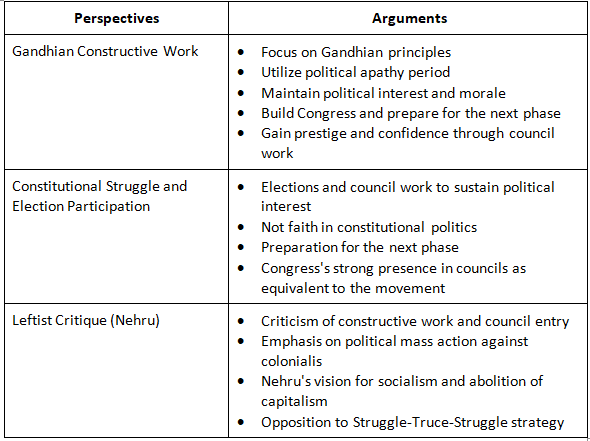UPSC Exam > UPSC Notes > History for UPSC CSE > Cheat Sheet: Debates on the Future Strategy after Civil Disobedience Movement
Cheat Sheet: Debates on the Future Strategy after Civil Disobedience Movement | History for UPSC CSE PDF Download
Introduction
The post-Civil Disobedience Movement period witnessed a two-stage debate among nationalists regarding the future strategy. The First Stage Debate involved three perspectives on constructive work, constitutional struggle, and leftist critique led by Jawaharlal Nehru. Nehru's vision emphasized the abolition of capitalism and the establishment of socialism. The Struggle-Truce-Struggle strategy proposed by Gandhi faced opposition from Nehru, who advocated a Struggle-Victory approach. The debate concluded with the Congress opting for council entry in the 1934 elections under the Government of India Act, 1935.
First Stage Debate Perspectives

Nehru’s Vision

Yes to Council Entry

Government of India Act, 1935

Evaluation of the Act

Second Stage Debate

Conclusion
The two-stage debate among nationalists following the withdrawal of the Civil Disobedience Movement shaped the future strategy, leading to the Congress's decision to participate in elections under the Government of India Act, 1935. This marked a significant shift in approach, with differing opinions on constructive work, constitutional struggle, and council entry. The long-term British strategy aimed at weakening the national movement through a combination of suppression and reforms. The rejection of the 1935 Act and subsequent entry into provincial legislatures became pivotal points in the evolution of the Indian nationalist movement.
The document Cheat Sheet: Debates on the Future Strategy after Civil Disobedience Movement | History for UPSC CSE is a part of the UPSC Course History for UPSC CSE.
All you need of UPSC at this link: UPSC
|
216 videos|855 docs|219 tests
|
FAQs on Cheat Sheet: Debates on the Future Strategy after Civil Disobedience Movement - History for UPSC CSE
| 1. What is the Civil Disobedience Movement and why is it important? |  |
Ans. The Civil Disobedience Movement was a major campaign of nonviolent resistance led by Mahatma Gandhi against British colonial rule in India during the 1930s. It aimed to challenge unjust laws and policies imposed by the British government and mobilize the Indian population in the struggle for independence. The movement played a crucial role in galvanizing public support and awareness, contributing to the eventual achievement of Indian independence.
| 2. What were the key objectives of the Civil Disobedience Movement? |  |
Ans. The Civil Disobedience Movement had several key objectives. Firstly, it aimed to secure complete independence for India from British rule. Secondly, it sought to challenge unjust laws and policies through nonviolent means, such as boycotts, protests, and noncooperation. Additionally, the movement aimed to mobilize the masses and foster a sense of national unity and pride among Indians. It also aimed to highlight the economic exploitation of Indians by the British and promote self-sufficiency through the promotion of local industries.
| 3. What were the strategies and tactics employed during the Civil Disobedience Movement? |  |
Ans. The Civil Disobedience Movement employed various strategies and tactics to challenge British rule. These included boycotting British goods, organizing mass protests and rallies, holding public meetings, engaging in acts of civil disobedience such as nonpayment of taxes, and promoting the use of indigenous products. Additionally, there were widespread acts of noncooperation with British authorities, including resigning from government positions, boycotting educational institutions, and participating in peaceful marches and satyagraha (nonviolent resistance) campaigns.
| 4. What impact did the Civil Disobedience Movement have on the Indian independence movement? |  |
Ans. The Civil Disobedience Movement had a significant impact on the Indian independence movement. It galvanized public support and participation, leading to a mass mobilization of Indians against British rule. The movement brought to the forefront the issue of India's independence and highlighted the unjust nature of British policies. It also led to widespread international attention and support for the Indian cause. Additionally, the movement played a crucial role in fostering a sense of national unity and pride among Indians, paving the way for future independence movements.
| 5. What lessons can be drawn from the Civil Disobedience Movement for future strategies in the struggle for social change? |  |
Ans. The Civil Disobedience Movement provides several important lessons for future strategies in the struggle for social change. Firstly, it underscores the power of nonviolent resistance and civil disobedience as effective means of challenging injustice and oppression. Secondly, it highlights the importance of mass mobilization and public participation in bringing about social change. Additionally, the movement emphasizes the significance of unity, perseverance, and strategic planning in the pursuit of social and political goals.
Related Searches





















